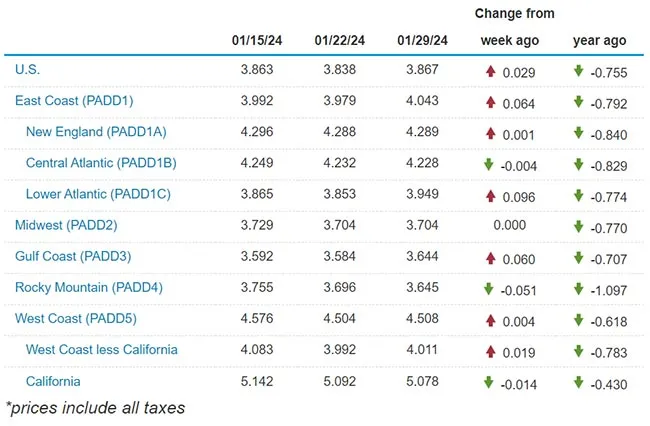Senior Reporter
Diesel Price Increase of 2.9¢ Lifts National Average to $3.867

[Stay on top of transportation news: Get TTNews in your inbox.]
The diesel price pendulum has swung forward this week with a 2.9-cent national average increase, according to data released Jan. 29 by the Energy Information Administration.
That puts diesel at $3.867 a gallon, which is 75.5 cents cheaper than a year ago.
The national average diesel price has alternated dropping and rising throughout the five reporting dates of January. Last week it dropped 2.5 cents after rising 3.5 cents the week before that.
The price rose in six regions, was flat in one and fell in three. The Rocky Mountain region saw a drop of 5.1 cents, while the Lower Atlantic saw an increase of 9.6 cents. The price was flat in the Midwest.
Gasoline also increased, rising 3.3 cents a gallon to hit a national average of $3.095.

De Haan
“We’ve seen the national average price of gasoline bounce back up after cold weather-related refinery shutdowns pushed up the wholesale price of gasoline,” Patrick De Haan, Gas Buddy head of petroleum analysis, said on his blog Jan. 29, adding that prices could rise in the spring. “Plus, recent gross domestic product data and new attacks in the Red Sea have pushed oil prices to their highest level since November.
“While prices have inched up and may continue to slowly rise, I believe the larger increases will be witnessed in a few weeks as we enter mid-February, lasting through April or May, during which the national average could rise 35 to 85 cents per gallon. Other issues and tensions could complicate how quickly prices rise or how high they go, so while the rise is not completely charted, it could deviate from our expectations.”
U.S. average retail prices for January 29, 2024:
Regular grade #gasoline: $3.10/gallon
On-highway #diesel: $3.87/gallon #gaspriceshttps://t.co/dsfxiPA8Wj — EIA (@EIAgov) January 30, 2024
In its final report on oil production in 2023, EIA reported U.S. energy producers in December processed 13.2 million barrels a day, the third month oil companies hit that number last year, with September and October being the other months. In November, the number was only fractionally lower, clearly indicating that in the last four months of the year, oil production was at a record level.
EIA said that during 2023 no month saw oil production fall below 12.5 million barrels per day, and the only months at that level were January and February.
For the full year, domestic oil production average averaged 12.9 million barrels per day, 1 million more than 2022’s level.
However, domestic production dipped in January because of the extreme cold weather in one of the country’s most productive oil reserves.

Flynn
EIA said production dipped by an estimated 1 million barrels per day to 12.3 million for the week ending Jan. 19, and commercial crude inventories in the U.S. dropped by 9.2 million barrels during the same period. In North Dakota, a blast of arctic weather hit the Bakken Formation, which covers large parts of North Dakota, Montana and the Canadian provinces of Manitoba and Saskatchewan. North Dakota is the third-largest crude-producing state in the country, and the state pipeline authority said weather was a factor in the drop by as much as 700,000 barrels per day.
“We have seen prices start to inch up, and the chances of seeing gasoline’s national average below $3 a gallon have been dashed,” oil industry analyst Phil Flynn with Price Futures Group told Transport Topics. Flynn blamed the increase on the recent Red Sea assaults and the attacks by suspected Iranian-backed rebels that killed three U.S. service members who were stationed at a facility along the Jordan-Iraq border.
On-Highway Diesel Fuel Prices

“Fundamentally, the oil markets are on solid ground. But [Jan. 29], the market spiked on the threat of the U.S. response to what was seen in Jordan. The risk of a military response is growing, and the risks to a disruption in the supply are increasing. The possibility of a significant price spike still looms, and the markets are waiting and seeing to see what happens. The markets [are] on edge.”
Flynn said he would not be surprised if West Texas Intermediate crude oil hits $80 a barrel by the end of the week. Oil closed Jan. 29 at $76.92. A year ago, oil traded at $77.90. It went the full year fluctuating between $68 and $93.
The weekly Baker Hughes rig count showed 621 rigs in operation through Jan. 19, which was one more than the previous week but 150 fewer than a year ago. The Canadian oil rig count increased by seven from the previous week to 230, down seven from the 2023 period.
Want more news? Listen to today's daily briefing below or go here for more info:




